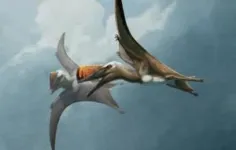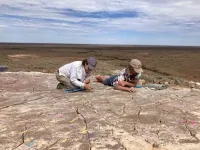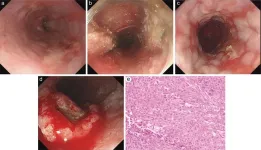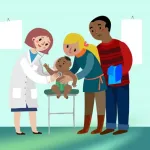(Press-News.org) The pterosaurs are extinct flying reptiles that lived alongside their close relatives, the dinosaurs. The largest of these reached 10 m in wingspan, but early forms were generally limited to around 2 m. In a new paper today, a team led by palaeontologist Dr David Hone of Queen Mary University of London and published in the journal Current Biology describes a new species of pterosaur that helps to explain this important transition.
They named the animal Skiphosoura bavarica meaning ‘sword tail from Bavaria’ because it comes from southern Germany and has a very unusual short, but stiff and pointed tail. The specimen is complete with nearly every single bone preserved and unusually, it is preserved in three dimensions, where most pterosaurs tend to be crushed flat. In life it would have been about 2 m in wingspan, similar to that of large birds like the golden eagle.
For two hundred years, palaeontologists split the pterosaurs into two major groups, the early non-pterodactyloids and the later and much larger pterodactyloids. The early pterosaurs had short heads on short necks, a short bone in the wrist of the wing, a long 5th toe on the foot and long tails, and the pterodactyloids had the opposite: large heads on long necks, a long wrist, short 5th toe and short tail. But which parts of their body changed when between these groups was not known.
In the 2010s, a series of intermediate species called darwinopterans were found that revealed that the head and neck had changed first before the rest of the body. It was a great example of an intermediate that bridged an evolutionary gap. But it also meant we did not really know what was going on before or after these changes.
Skiphosoura reveals these changes. Evolutionarily it sits between these earlier darwinopterans and the pterodactyloids. It retains a very pterodactyloid-like head and neck, but also shows a longer wrist, and a shorter toe and tail than earlier darwinopterans but these are not as extreme as those seen in the pterodactyloids. With the study also comes a new reconstruction of the evolutionary family tree for pterosaurs. In addition to showing the intermediate position of Skiphosoura, it also shows that a Scottish pterosaur, Dearc, as fitting in the mirror position between the early pterosaurs and the first darwinopterans.
In other words, we now have a complete sequence of evolution from early pterosaurs to Dearc, to the first darwinopterans to Skiphosoura, to the pterodactyloids. While not every specimen is complete, we can now trace the increase in size of the head and neck, the elongating wrist, shrinking toe and tail and other features step-by-step across multiple groups. It’s a superb illustration of the evolution of a group for which the transition has been far from clear before.
Both Dearc and Skiphosoura are unusually large for their time also suggesting that the changes that enabled the pterodactlyoids to reach enormous sizes were appearing even in these transitional species.
Dr David Hone, from Queen Mary University of London, said: “This is an incredible find. It really helps us piece together how these amazing flying animals lived and evolved. Hopefully this study will be the basis for more work in the future on this important evolutionary transition”.
Adam Fitch, from the University of Wisconsin-Maddison, said: “Pterosaurs have long been symbols of the unique life of the past. Skiphosoura represents an important new form for working out pterosaur evolutionary relationships and by extension how this lineage arose and changed."
René Lauer of the Lauer Foundation said: “The specimen was disarticulated with bones of varying quality often overlaid upon one another. Digital photography of the specimen taken in both visible and UV light significantly aided in the process to identify these elements and to better analyze finer details that were not discernible in normal daylight alone” and Bruce Lauer of the Lauer Foundation said: “The Lauer Foundation is proud to have the opportunity to bring this important specimen to science and further the understanding of pterosaur evolution”.
Stefan Selzer an author on the project who prepared the specimen said: “As a preparator I have worked on more than 60 pterosaur specimens from Solnhofen limestone. I recognized during the final prep this specimen showed features that combined characteristics of both major groups of pterosaurs, with the shortened tail as the most important diagnostic feature.”
END
New fossil reveals the evolution of flying reptiles
Complete specimen shows how the pterosaurs changed from early forms to the later giants
2024-11-18
ELSE PRESS RELEASES FROM THIS DATE:
Redefining net zero will not stop global warming – scientists say
2024-11-18
In a new study,1 led by the University of Oxford’s Department of Physics and published today (18 November) in Nature, an international group of authors who developed the science behind net zero demonstrate that relying on ‘natural carbon sinks’ like forests and oceans to offset ongoing CO2 emissions from fossil fuel use will not actually stop global warming.
The science of net zero, developed over 15 years ago,2 does not include these natural carbon sinks in the definition of net human-induced CO2 emissions.
Natural sinks play a vital role to moderate the impact of current emissions and draw down atmospheric CO2 concentrations after the date of net zero, ...
Prevalence of cardiovascular-kidney-metabolic syndrome stages by social determinants of health
2024-11-18
About The Study: The results of this study suggest a disproportionate burden of cardiovascular-kidney-metabolic syndrome by social determinants of health and sex. These findings highlight the need to address inequities in cardiovascular-kidney-metabolic syndrome through targeted interventions.
Corresponding Author: To contact the corresponding author, Jie Guo, PhD, email jie.guo@ki.se.
To access the embargoed study: Visit our For The Media website at this link https://media.jamanetwork.com/
(doi:10.1001/jamanetworkopen.2024.45309)
Editor’s Note: Please see the article for ...
Tiny worm makes for big evolutionary discovery
2024-11-18
Everyone has a past. That includes the millions of species of insects, arachnids, and nematode worms that make up a major animal group called the Ecdysozoa.
Until recently, details about this group’s most distant past have been elusive. But a UC Riverside-led team has now identified the oldest known ecdysozoan in the fossil record and the only one from the Precambrian period. Their discovery of Uncus dzaugisi, a worm-like creature rarely over a few centimeters in length, is described in a paper published today in Current ...
Cause of the yo-yo effect deciphered
2024-11-18
Anyone who has ever tried to get rid of a few extra kilos knows the frustration: the weight drops initially, only to be back within a matter of weeks – the yo-yo effect has struck. Researchers at ETH Zurich have now been able to show that this is all down to epigenetics.
Epigenetics is the part of genetics that’s based not on the sequence of genetic building blocks but on small yet characteristic chemical markers on these building blocks. The sequence of building blocks has evolved over a long period of time; we all inherit them from our parents. Epigenetic markers, on the other hand, are more dynamic: environmental factors, our eating habits and the condition of our body ...
Suicide rates for young male cancer survivors triple in recent years
2024-11-18
LOS ANGELES — New research published in JAMA Network Open from USC Norris Comprehensive Cancer Center, part of Keck Medicine of USC, suggests that among all cancer survivors, male adolescents and young adults (AYA) have the highest rate of death by suicide.
The study also reports that the number of suicide deaths in the AYA male cancer survivor group (ages 15-39) increased three-fold during the 21-year-study period. In 2021, one in 65 deaths among the group was attributed to suicide. Suicide deaths have also increased for other cancer ...
Achalasia and esophageal cancer: A case report and literature review
2024-11-18
Achalasia is primarily caused by the degeneration of the myenteric plexus in the esophageal wall, leading to impaired relaxation of the lower esophageal sphincter (LES) and loss of esophageal peristalsis. Although the exact etiology is not fully understood, it is believed to involve autoimmune mechanisms and viral infections. Key pathological features include the absence of peristalsis, LES hypertonicity, and symptoms such as dysphagia and regurgitation. In this condition, the esophagus fails to contract and move food toward the stomach, while the LES ...
Authoritative review makes connections between electron density topology, future of materials modeling and how we understand mechanisms of phenomena in familiar devices at the atomistic level
2024-11-18
2024 marks an important milestone with the publication of a comprehensive review in Chemical Reviews on electron density-based methods. The review, authored by an international team, was spearheaded by leading researchers from Institute of Science Tokyo (Sergei Manzhos and Manabu Ihara of the Ihara-Manzhos lab) and included collaborators from Canada (Paul Ayers of McMaster University and Cherif Matta of Mount Saint Vincent University), China (Samantha Jenkins of Hunan Normal University), and the USA (Michele Pavanello from Rutgers University). The project also saw significant contributions from young researchers, Daniel Koch from ...
Understanding neonatal infectious diseases in low- and middle-income countries: New insights from a 30-year study
2024-11-18
Researchers from Peking University have conducted an in-depth study on the epidemic status, secular trends, and risk factors of 15 common neonatal infectious diseases across low- and middle-income countries (LMICs) from 1990 to 2019. The study, published in Health Data Science, provides a comprehensive overview of the changes in incidence and mortality rates, identifying key trends and potential areas for targeted public health interventions to improve neonatal health outcomes.
Neonatal infectious diseases remain a significant cause of morbidity and mortality in LMICs, where newborns are particularly vulnerable to infections due to underdeveloped immune systems ...
This year’s dazzling aurora produced a spectacular display… of citizen science
2024-11-18
Citizen scientists in Japan enabled researchers to learn why May 2024’s aurora appeared a magenta color over the country. This effort in extending research beyond academies and laboratories has greater consequence for humanity than explaining pretty lights
Around the world, the historic geomagnetic superstorm of late spring 2024 inspired millions of non-scientists around the world—many armed with highly sensitive smartphone cameras—to take a fantastic, unprecedented number of images of the aurora it produced.
In ...
New oral drug to calm abdominal pain
2024-11-18
University of Queensland researchers have developed a new class of oral painkillers to suppress chronic abdominal pain that is based on the peptide hormone oxytocin that drives childbirth contractions.
Associate Professor Markus Muttenthaler from UQ’s Institute for Molecular Bioscience led a team that has changed the chemical structure of oxytocin to make it gut-stable after earlier work revealed the hormone could treat abdominal pain.
Dr Muttenthaler said there was an urgent need for new ...
LAST 30 PRESS RELEASES:
New expert guidance urges caution before surgery for patients with treatment-resistant constipation
Solar hydrogen can now be produced efficiently without the scarce metal platinum
Sleeping in on weekends may help boost teens’ mental health
Study: Teens use cellphones for an hour a day at school
After more than two years of war, Palestinian children are hungry, denied education and “like the living dead”
The untold story of life with Prader-Willi syndrome - according to the siblings who live it
How the parasite that ‘gave up sex’ found more hosts – and why its victory won’t last
When is it time to jump? The boiling frog problem of AI use in physics education
Twitter data reveals partisan divide in understanding why pollen season's getting worse
AI is quick but risky for updating old software
Revolutionizing biosecurity: new multi-omics framework to transform invasive species management
From ancient herb to modern medicine: new review unveils the multi-targeted healing potential of Borago officinalis
Building a global scientific community: Biological Diversity Journal announces dual recruitment of Editorial Board and Youth Editorial Board members
Microbes that break down antibiotics help protect ecosystems under drug pollution
Smart biochar that remembers pollutants offers a new way to clean water and recycle biomass
Rice genes matter more than domestication in shaping plant microbiomes
Ticking time bomb: Some farmers report as many as 70 tick encounters over a 6-month period
Turning garden and crop waste into plastics
Scientists discover ‘platypus galaxies’ in the early universe
Seeing thyroid cancer in a new light: when AI meets label-free imaging in the operating room
Neutrophil-to-lymphocyte ratio may aid risk stratification in depressive disorder
2026 Seismological Society of America Annual Meeting
AI-powered ECG analysis offers promising path for early detection of chronic obstructive pulmonary disease, says Mount Sinai researchers
GIMM uncovers flaws in lab-grown heart cells and paves the way for improved treatments
Cracking the evolutionary code of sleep
Medications could help the aging brain cope with surgery, memory impairment
Back pain linked to worse sleep years later in men over 65, according to study
CDC urges ‘shared decision-making’ on some childhood vaccines; many unclear about what that means
New research finds that an ‘equal treatment’ approach to economic opportunity advertising can backfire
Researchers create shape-shifting, self-navigating microparticles
[Press-News.org] New fossil reveals the evolution of flying reptilesComplete specimen shows how the pterosaurs changed from early forms to the later giants





